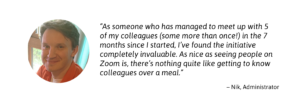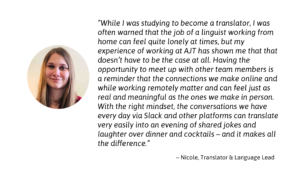The importance of real-life interactions for remote teams
In January 2021, our company made a strategic business decision to go fully remote and 14 of us bade a fond farewell to our seaside office in Newquay, Cornwall. We’re now a team of 31 which means over half of us have only ever experienced AJT as a fully remote workplace.
While everyone in the team agrees that working from home has many advantages, it’s clear from speaking to each other that we’ve all been craving real-life team interactions, no doubt accentuated by the pandemic. Newer team members want to get to know their colleagues better, build meaningful relationships in their new job and feel a deeper sense of belonging to the team. The ‘Newquay’ crew miss having face-to-face contact with their colleagues and the easy, unprompted interactions that spring up when you work in the same office.
So recently, we introduced an annual meet-up budget of £350 per person to facilitate our colleagues meeting up in real life (IRL). We actively encourage team members to spend their personal budget on meeting up with each other so they can get to know each other and create shared experiences. In a short space of six months, team members have already met up in Birmingham, Exeter, Frankfurt, Lagos, Leicester, London, Newquay and Vienna and the response has been excellent.
Here are our top six reasons for enabling remote team members to meet up IRL and for wanting them to get to know each other away from the home office:
1. Creates stronger bonds
I still fondly remember my handball training camp excursions as a teenager. We’d go away together as a team for three or four days at a time. We’d spend 25% of our time together actually training and playing handball and the other 75% travelling to and from a local youth hostel, sharing mealtimes, visiting the town centre, playing cards and just joking around.
Of course, the training sessions and drills helped us to hone our technical skills (although no amount of training could have improved my poor sense of proprioception!). But hanging out and getting to know each other off the pitch made us a better team on the pitch. When you know each other well and you know what makes your teammates tick, you intuitively play better together. You know how to motivate each other and really come together as a team when the going gets tough. Whether it’s in sport or in business, we know that spending time with teammates beyond our day-to-day interactions creates stronger bonds. These stronger bonds help to create a happier and more harmonious working environment, which in turn leads to better team performance. To put in the words of the great Jürgen Klopp: “If you want special results, you have to feel special things and do special things together. You can speak about spirit, or you can live it.”
2. Builds trust
Trust is a fundamental basis for building great teams. The better we know our colleagues, the more open and honest we can be and the more we can then trust each other. This in turn makes it easier to rely on each other and work together more collaboratively. But trust doesn’t just happen overnight. We have to build up trust by spending time together, learning more about each other, becoming more familiar with each other and by creating shared experiences. These shared experiences create goodwill which in turn helps us to bond and build a rapport with each other. They help us get to know the whole person, not just the part of a person that relates to work. In a remote set-up, building relationships and trust doesn’t come as easily as in an office environment. It takes greater effort and more time. Meeting up and getting to know each other outside of work helps remote teams build trust sooner.

3. Improves communication
Using remote communication tools can be a bit like speaking to someone for the first time when you’re both wearing face masks. You’re not quite getting the whole picture. The sound is a bit muffled, making it harder to hear. Facial expressions are harder to grasp so it’s difficult to tell how someone is really feeling. You can end up compensating for this, speaking a bit louder, maybe choosing simpler sentence structures or words and being extra smiley with your eyes to facilitate the conversation. But still, it’s easy to misinterpret expressions or mishear what’s being said.
A large percentage of communication is based on non-verbal clues rather than the actual words we utter. When we communicate at work via instant messaging tools like Skype, Slack, or Teams, many of these non-verbal clues are lost. As linguists, we try to compensate by using extra clear language, and by adding emojis to emphasise meaning – but it’s far from perfect (even emojis are not interpreted the same way by everybody). On face-to-face video calls like Zoom, our conversation partner is only able to see our head and shoulders, so any body language is limited. And this means that what we’re saying or the point we’re trying to make may not necessarily be received in the way we intended. But if we know our colleagues well and understand their character, and if we know how they like to express themselves and how they tend to think about things, the better the chances are that we will interpret their communication in the way they were meant, reducing the risk of misunderstanding each other.
4. Increases context
When we worked from the office and spent all day with colleagues, we would see ‘all’ of them and be able to pick up on any non-verbal clues. We were able to judge a person’s mood throughout the day, view team interactions and gain an insight into conversations being had around the office. In a remote set-up we tend to communicate more on a transactional basis. We like to give someone a call when we have something concrete to discuss. Impromptu conversations that were had while waiting for the computer to switch on or during a quick coffee break no longer exist. We’re not necessarily seeing the whole person and understanding the bigger picture and we have less context to form a holistic, well-balanced opinion of someone.
So, if there is a problem at work, or someone makes a mistake or makes a comment that’s a bit off, it could mean that our opinion of a colleague is condensed down to that one problem or behaviour. Especially when it comes to newer team members where we can’t draw from previous shared experiences. And that can lead to things being blown out of proportion. Building relationships outside of work helps us to collaborate better as a remote team. When we know a person well, we simply have more context to help us interpret communication in the way it’s intended.
5. Encourages collaboration
According to studies conducted by Microsoft, as companies had to shift to remote working during the pandemic, the level of focus of individual team members increased, but the level of collaboration between team members decreased. When we don’t work in the same physical space as our colleagues, things are quieter, we don’t get interrupted as much (family interruptions aside of course) and we can work in a more focused way. But at the same time, communication between colleagues reduces to primarily interacting with the team members we work with most closely day to day rather than the wider team. In effect, our networks at work are at risk of shrinking.
Here at AJT, when we still had our office, translators from different language teams would often chat to each other, because they sat next to each other. Translators and project managers could easily just ask a question across the room if they needed help. Our Head of Operations Nikki could see when someone was having a bad day and suggest going on a walk around the block to get some fresh air and have a chat. Just by being in the same space, everyone was more interconnected and more aware of what was going on in other areas. This is known as social capital – the interpersonal connections and relationships between people that work together.
In a remote working environment, we have less opportunity for impromptu chats and informal interactions. We’re not going to be able to contribute to a conversation just by being in the room. There are no typical ‘water cooler’ opportunities or chats about the weekend while we wait for the kettle to boil. And less interaction often leads to less collaboration. We need to create opportunities for our remote team members to meet outside of work to help build our collective social capital, which will in turn increase collaboration.
6. Reduces stress
Finally, we can’t underestimate the correlation between good working relationships and stress. When we get to know our colleagues outside of work and build trust and a rapport, we’re also contributing to creating a happier and more joyful working environment. There is a simple but powerful correlation: work is more fun and less stressful when you get on well with your colleagues. When you feel at ease, safe and supported, it becomes less daunting to deal with everyday work challenges. You know that your colleagues have got your back, that you can solve the challenge as a team and that you can ask questions without being judged. All that makes work a less stressful place to be.
It goes without saying that building team spirit and fostering a happy, collaborative work environment is not just good for our colleagues, it’s also good for our customers. After all, we know that happy teams perform better, delivering better quality and better customer service.
As we come up to a new financial year and a renewed budget, I can’t wait to see where my colleagues will meet up. There is already talk of a weekend away somewhere near Cambridge and a possible meet-up in a villa in Seville – watch this space!


